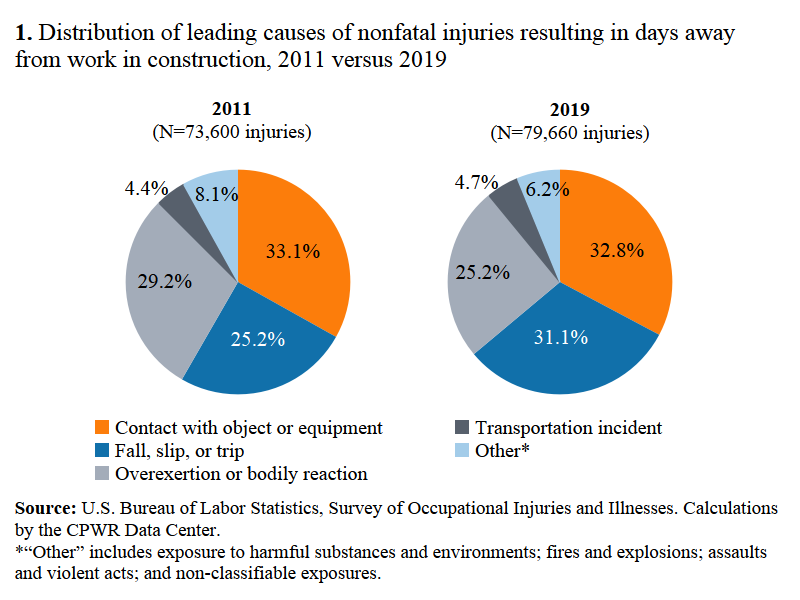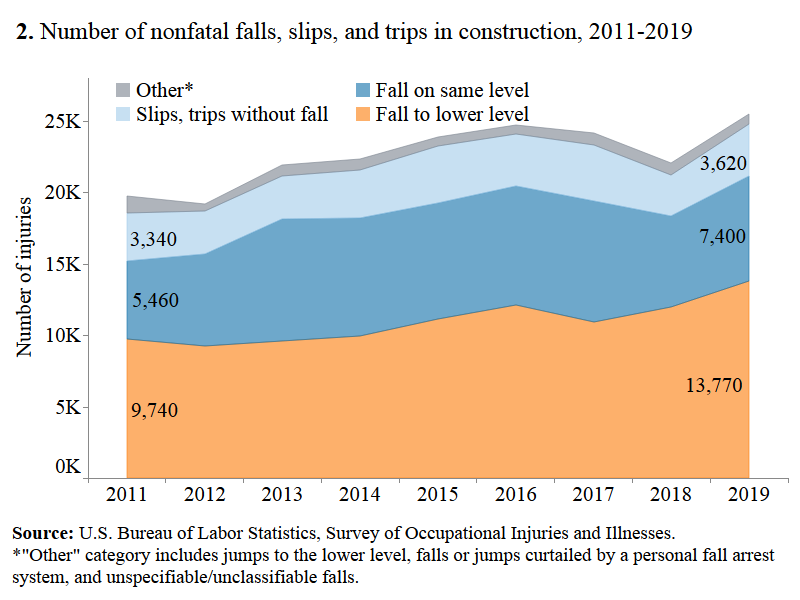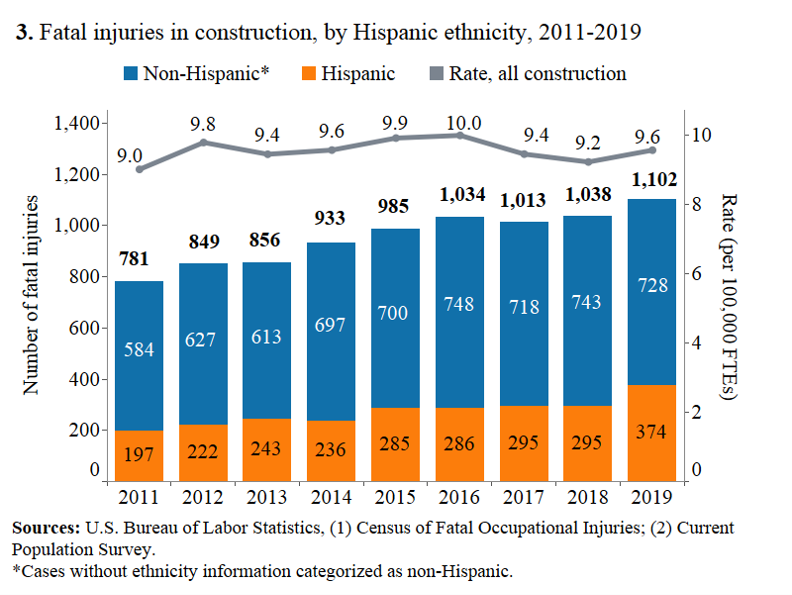Stand-Down for Falls in Its 8th Year: Continuing Need to Prevent Falls in Construction in the U.S. and Internationally
Posted on by
The National Campaign to Prevent Falls in Construction was launched in 2012 through the NORA Construction Sector Council with leadership from NIOSH, OSHA, and CPWR – The Center for Construction Research and Training to address the high rate of both fatal and nonfatal falls in the industry. While we encourage participation in the Campaign year-round, each spring, a Safety Stand-Down is held to encourage employers across the country to focus on fall prevention. The 2021 National Safety Stand-Down to Prevent Falls is set for May 3-7 to coincide with Construction Safety Week.
If you have previously participated in the annual Stand-Down, we encourage you to continue; and if you haven’t, make the time to join. New virtual events, resources, and information on simple ways to participate in the Stand-Down are available here.
Current data
In December 2020, CPWR examined trends in employer-reported nonfatal injuries in construction using the latest data from the U.S. Bureau of Labor Statistics (BLS). The total number of non-fatal injuries in construction increased from 2011 (73,600 injuries) to 2019 (79,660 injuries). Injuries in the category, “falls, slips, or trips” increased from 25% to 31% of the total during that time (Figure 1). In 2019, falls to a lower level made up 54 percent of the falls, slips, and trips. This represents a 42% increase in falls to a lower level from 2011 to 2019 (Figure 2).


In February 2021, CPWR examined trends in fatal injuries among construction workers using BLS data. The number of fatal injuries in construction has continued to increase and in 2019 reached the highest level since 2011 (from 781 fatal injuries in 2011 to 1,102 fatal injuries in 2019 [about 41% increase] Figure 3). Figure 3 also shows that fatal injuries among Hispanic construction workers increased disproportionately (197 fatal injuries in 2011 increased to 374 fatal injuries in 2019 — an approximately 90% increase). In 2019, the 401 falls to a lower level accounted for 57% of the total number of 709 construction fatalities caused by the Construction Focus Four (Figure 4). The number of construction fatalities for which roofs, ladders, or scaffolds were the primary source grew from 2011 to 2019, contributing significantly to the overall increase in fatal falls to a lower level over these years. Among those, deaths involving roofs specifically increased in 2019 (146 deaths) compared to 2018 (114 deaths).


Big picture — fall prevention is an international issue
Fall prevention, and fatal and non-fatal injuries from falls, are also important issues internationally. While we continue to work to prevent these problems in the U.S., we can also learn from others around the world. Choi et al. (2019) compared the fatal occupational injuries (FOIs) in the construction industry in the U.S., South Korea, and China. Their study findings indicated that “falls from a higher level” and “struck by” were the top common accident types in all three countries. Their study also discussed implications and recommendations for FOIs prevention in construction such as the employers’ responsibility on properly providing/installing fall protection systems to protect their workers before work begins. Additionally, emphasis on training and education is crucial so that employees can familiarize themselves with all potential fall hazards and fall protection systems on a worksite prior to starting work.

Considering other examples from around the globe to combat the high incidents of “falls from elevation” can be helpful. While Singapore registered a record low in number and rate of workplace fatalities in 2019, falls from heights has been noted as an emerging fatal injury concern contributing to more than a third of total workplace fatalities in Singapore annually. The Singapore Workplace Safety and Health (WSH) Council has produced the resource “Preventing Falls from Heights: Learn what you can do to eliminate or reduce the risk of falls from heights” which describes the “Fall Prevention Plan (FPP)” and “Permit-to-Work (PTW) System” to eliminate or reduce the risk of falls from heights. Hazard identification, risk assessment, and appropriate implementation of control measures are key parts of these fall prevention efforts.
Continuing to work on new approaches for prevention
A review (Sinyai and Choi [2020]) of fifteen years of construction occupational safety and health research in the U.S. addressed important questions such as “what construction occupational safety and health problems are under study?” They found that “falls” was the most-studied safety hazard. They also found that a growing number of studies are targeted at segments of the workforce identified in surveillance research as being at disproportionate risk, such as small or residential contractors, Latino
and immigrant, or younger workers. Among other findings, the study: (1) emphasized the continuing need for interdisciplinary research approaches, covering both health and engineering disciplines; and (2) supports the need for continuing innovative approaches such as Prevention through Design (PtD) and Safety Culture/Climate studies to inform a new generation of intervention research.
Despite ongoing efforts by construction employers and safety professionals to prevent falls, provide fall protection systems, and train workers, falls continue to be the leading cause of death in the construction industry. Fall injuries are preventable. We hope you take part in the National Campaign to Prevent Falls in Construction as part of our continued national effort to prevent falls among construction workers.
CPWR Fall Experience Survey
In 2021 CPWR has worked closely with the ANSI Z359 National Work at Heights Task Force and the NORA Construction Sector Council Falls Work Group to develop a “Fall Experience Survey” which aims to fill in some of the gaps in information available on common underlying causes of falls from heights. The survey is intended to: (1) better understand the needs of workers and the industry including the intricacies of how different organizational, human, and physical factors can interact to cause a fall; (2) provide information to guide in the development of new CPWR and NORA materials in support of the National Campaign & Annual Safety Stand-Down to Prevent Falls in Construction and (3) to inform the voluntary standards put forward by the ANSI Z359 Accredited Standards Committee. For more information about the survey and its goals, you can view an on-demand webinar from December 15, 2020, Identifying Common Root Causes of Falls from Heights. The survey will remain open through May 7, 2021, and we encourage you and your crew to complete it anonymously during your activities. Results and recommendations will be shared as part of the ongoing, year-round campaign. Click here to take the 15-minute survey.
We would love to hear from you!
In the comment section below, tell us how your company is preventing falls, share your personal story of how fall protection saved your life, or let us know what plans are in the works to have a virtual or socially distanced Stand-Down to prevent falls. We’d also love to hear any other ideas for how we can expand our reach at the national level, and what more we can do to support you in the field.
If you have participated in a National Safety Stand-Down to Prevent Falls (aka “Falls Stand-Down”) in your workplace, please let us know:
- What positive changes, for workers or workplaces, came out of participating in a Falls Stand-Down?
- How can these events be improved – so that everyone in your workplace is able to benefit from a Falls Stand-Down event?
- How can we keep the momentum going to focus on fall prevention all year long?
Douglas Trout, MD, MHS, is a Medical Officer at NIOSH.
Sang D. Choi, Ph.D., MPH(c), CSP, CPE, is Professor & Director of the Center for OESH and Coordinator of the Construction Safety Program in the Department of Occupational & Environmental Safety & Health at the University of Wisconsin – Whitewater.
Scott Earnest, PhD, PE, CSP, is the Associate Director for Construction Safety and Health.
CDR Elizabeth Garza, MPH, CPH, is Assistant Coordinator for the Construction Sector in the NIOSH Office of Construction Safety and Health.
Mark your calendars!
Tuesday, April 20th, 2021 at 2:00pm EST (1.5 hrs)
Fall Protection Q&A Panel PART II
CPWR is hosting a virtual Q&A panel with members of the ANSI Z359 Accredited Standards Committee just before the 2021 Stand-Down (May 3-7). In this 90-minute webinar, you can expect more tips and techniques to utilize the ANSI/ASSP Z359 Standards and improve your fall protection programs to keep workers safe on the jobsite, but the content will be driven by your questions. We encourage you to submit a question or two in advance at the registration link here.
Last year’s virtual Q&A panel with members of the ANSI Z359 Accredited Standards Committee is – available on-demand here.
Wednesday, April 28th, 2021 at 1:00pm EST
Fall Harness Fit: The Basics
In order for a personal fall arrest system (PFAS) to effectively protect workers in the event of a fall, it’s critical that the harness fits properly and is worn as intended. CPWR is partnering with the National Roofing Contractors Association (NRCA) to provide an educational webinar on this topic including demonstrations and descriptions of how a harness should look and feel when worn. We encourage you to submit a question or two in advance at the registration link here.
This webinar will be recorded and available to view on-demand following the event. For more from the NRCA, check out last year’s webinar Fall Prevention & Protection in the Roofing Industry.
Resources
Check out our main campaign site. We will post new resources and a planner on activities that are ‘ready to go’ each day. We will provide additional resources on how to engage virtually or through a socially distanced stand-down. Access toolbox talks, infographics, training materials, and other Stand-Down resources (in English and Spanish) on the One Stop Stand-Down Shop page. A virtual stand-down option will be available for companies with a selection of Stand-Down videos. Play videos for employees over a video conferencing platform and discuss how the information can be applied to your jobsites:
OSHA Stand-Down website National Safety Stand-Down to Prevent Falls in Construction | Occupational Safety and Health Administration (osha.gov)
NIOSH
National Campaign to Prevent Falls in Construction
Constructions Safety and Health
CPWR
R2P partnerships – Fall Prevention
Planificar. Proporcionar. Capacitar
Prevent Falls Resources en-espanol
Safety Culture and Safety Climate
Foundations for Safety Leadership
Data
CPWR Data Center CPWR | Data Reports
U.S. Bureau of Labor Statistics. Current Population Survey (CPS). 2016-2019
U.S. Bureau of Labor Statistics. Survey of Occupational Injuries and Illnesses (SOII). 1992-2019
References
Sinyai C and Choi S [2020]. Fifteen year of American construction occupational safety and health research. Safety Science, 131, 104915. doi:10.1016/j.ssci.2020.104915
Choi SD, Guo L, Kim JH, and Xiong S. [2019]. Comparison of fatal occupational injuries in construction industry in the United States, South Korea, and China. International Journal of Industrial Ergonomics, 71, 64-74. doi: 10.1016/j.ergon.2019.02.011
Post a Comment